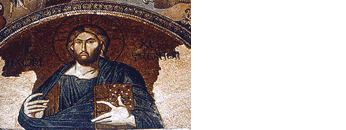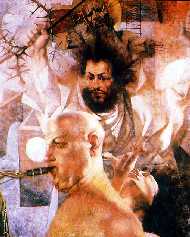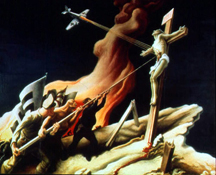
|
|
|
|
| Class
Prep |
|
|
|
Becoming the Son of God: Trajectories in Early Christianity
 In Siegfried Reinhardt's painting "Light," the figure of Christ commands attention in a burst of light at the center of the image, but the people surrounding him don't seem to notice. How much of the tradition about Jesus has developed apart from the message and life of the historical man from Palestine? Are those developments all for the good, or should we be paying more attention to them, analyzing their claims and consequences? In Siegfried Reinhardt's painting "Light," the figure of Christ commands attention in a burst of light at the center of the image, but the people surrounding him don't seem to notice. How much of the tradition about Jesus has developed apart from the message and life of the historical man from Palestine? Are those developments all for the good, or should we be paying more attention to them, analyzing their claims and consequences?-
- In our last class, we began to explore and discuss the traditions about Jesus that began to develop in the earliest years of Christianity. We will continue that discussion today as we look at texts from gospels that didn't make the canonical cut.
-
- The original Gospels of Thomas, Mary (Magdalene), and Peter probably date to the second and third centuries after Jesus (the manuscript witnesses that have survived, some of which have only been unearthed in the past 120 years, are copies dating from the fourth century and later). They demonstrate that gospels about Jesus' teachings and death/resurrection continued to be written well after the canonical four. Some scholars have argued that parts of these gospels, particularly Thomas and Peter, may actually predate the canonical gospels, an issue we dealt with earlier in the quarter.
-
 For today, choose one of the three and read it through (the texts are in The Complete Gospels, but if you don't have that book, you'll find links to online sources below). Then Google your gospel and see what's "out there." These noncanonical gospels have generated a lot of interest at both the professional and popular level; make a note of the claims you find in popular sources on the internet and try to judge how historical those claims are. Be prepared to introduce a few examples and your assessment of them in class. For today, choose one of the three and read it through (the texts are in The Complete Gospels, but if you don't have that book, you'll find links to online sources below). Then Google your gospel and see what's "out there." These noncanonical gospels have generated a lot of interest at both the professional and popular level; make a note of the claims you find in popular sources on the internet and try to judge how historical those claims are. Be prepared to introduce a few examples and your assessment of them in class.-
- Finally, choose one of the three chapters in The Historical Jesus for Dummies listed below. One deals with various cultural constructions of Jesus, the second with Jesus in art, and the third with Jesus in film. As you read, consider the contrasts and comparisons between the study of the historical Jesus, which too is a part of cultural history, and thesemore recent interpretations of Jesus, such as Thomas Hart Benton's war poster, "Again," depicting the crucified Jesus (a figure of the Allied powers in World War II) under attack by the Axis powers (Italy, Germany and Japan).
-
-
-
- Assigned Readings
-
-
| Primary: |
Choose from one of the following and read it in CG (online links are also provided): Gospel of Thomas, Gospel of Peter, Gospel of Mary |
| Secondary: |
Locate, read and evaluate online sources on your gospel; Murphy, HJFD chapter 16, 17 or 18 (Camino); online class prep |
Lecture Slides: |
Class 10a (pdf) |
-
-
- Further Reading
-
- King, Karen L. What Is Gnosticism? Cambridge, Massachusetts: Belknap Press of Harvard University Press, 2005.
-
- McDonald, Lee Martin. The Story of Jesus in History and Faith: An Introduction. Grand Rapids, Michigan: Baker, 2013.
-
- Meyer, Marvin, ed. The Nag Hammadi Scriptures: The Revised and Updated Translation of Sacred Gnostic Texts Complete in One Volume. New York: HarperOne, 2009.
-
- Pagels, Elaine and Karen L. King. The Gospel of Judas and the Shaping of Christianity. New York: Viking, 2007.
-
- Pearson, Birger A. Ancient Gnosticism: Traditions and Literature. Minneapolis: Fortress, 2007.
-
- There is a new series from Bloomsbury Publishing relevant to this topic: "The Reception of Jesus in the First Three Centuries."
-
-
- Links
-
- The Gnostic Society Library - This website contains over a thousand Gnostic documents, including the Nag Hammadi Library (but not the Gospel of Judas).
- The Lost Gospel of Judas, National Geographic - This gospel likely was part of the Nag Hammadi corpus originally, and was sold on the black market. In 2006, after an antiquities collector made the manuscript available to scholars for research, National Geographic produced a program and Web site to present the manuscript to the public. There’s a lot of interesting information on the website about the reconstruction, text, and significance of the manuscript.
- Noncanonical Literature - This website, hosted by the Wesley Center online, provides access to the full range of Old and New Testament Apocrypha and Pseudepigrapha, including the "heretical" materials like the gnostic gospels.
- Orion Center for the Study of the Dead Sea Scrolls - hosted at the Hebrew University of Jerusalem, this rich site provides an excellent virtual tour of the Qumran site and a full bibliography for the study of the scrolls.
-
-
- Sources
-
- Photographs:
-
- Siegfried Reinhardt, "Light" (1959). Photograph by Joseph Szaszfai; reprinted in Jaroslav Pelikan, Jesus Through the Centuries: His Place in the History of Culture (New Haven: Yale University Press, 1985) plate facing p. 79, text p. 72.
- Thomas Hart Benton, "Again" (1940), The National Archives, Washington, D.C. Benton uses an image of Golgotha, the scene of Jesus' crucifixion, to evoke the threat to western civilization posted by the Axis powers (a stereotypical Italian fascist, Nazi, and Japanese figures thrust a common lance into Jesus' side, while a German Messerschmitt sprays him with bullets. The image presumes that the Allies (Britain, France and soon the U.S.) are allied with Christ and represent the only remaining hope for all that is good.
-
-
|
|
|
|
|
